Hello, everyone, welcome to “Inconvenient Truths”. I am your host Jennifer Zeng.
A while ago there was a leak in China’s Taishan Nuclear Power Plant, which is very close to Hong Kong. The leak has caused a lot of media attention, and a viewer asked me to talk about it. So today I will not only talk about the incident itself, but will also talk about a suicide that could have some connection with the leak. No other English media has covered this. So this is my exclusive report.
I will then give you an in-depth coverage of the CCP’s ambitious “nuclear dream”, and explain why the world should be very worried about it.
I will also give you a quick update about the issues surrounding the defection of CCP’s top counterintelligence official Dong Jingwei.
Before we move on, please make sure you subscribe to and share my channel.
One viewer left a comment on my last show, saying that “I am really surprised why this channel has so less subscribers and so less likes… really surprising.. I think people cannot digest truth neither convenient or inconvenient”.
And my reply is: “I think we need to thank YouTube for this too…”
Another viewer said, “Hi Jennifer, I conducted a little experiment on your channel. I had three identical devices watching your broadcast at the same time. I hit a like on one device but it didn’t register on the other two. I then did the same on the other two devices and the same thing happened. Also the number of people watching was different on each device. The number consistently dropped throughout the broadcast on two devices.”
So, you see, we do need to fight hard against the suppression. And thank you very much for your support.
Now, let’s move to our topics today.
Quick Updates about Dong Jingwei’s Alleged Defection
We talked about reports about Dong Jingwei’s defection, and the CCP’s strange responses in our last show.
Since then there have been two major updates.
One is that SpyTalk, which published a story about Dong Jingwen before, was approached by “a U.S. official” who said that the reports about Dong Jingwen were “not accurate”.
Another is that the CCP published a report yesterday (June 23), with a photo that has Dong in it, saying that Dong attended the 16th meeting of the security council secretaries of the Shanghai Cooperation Organization member states.
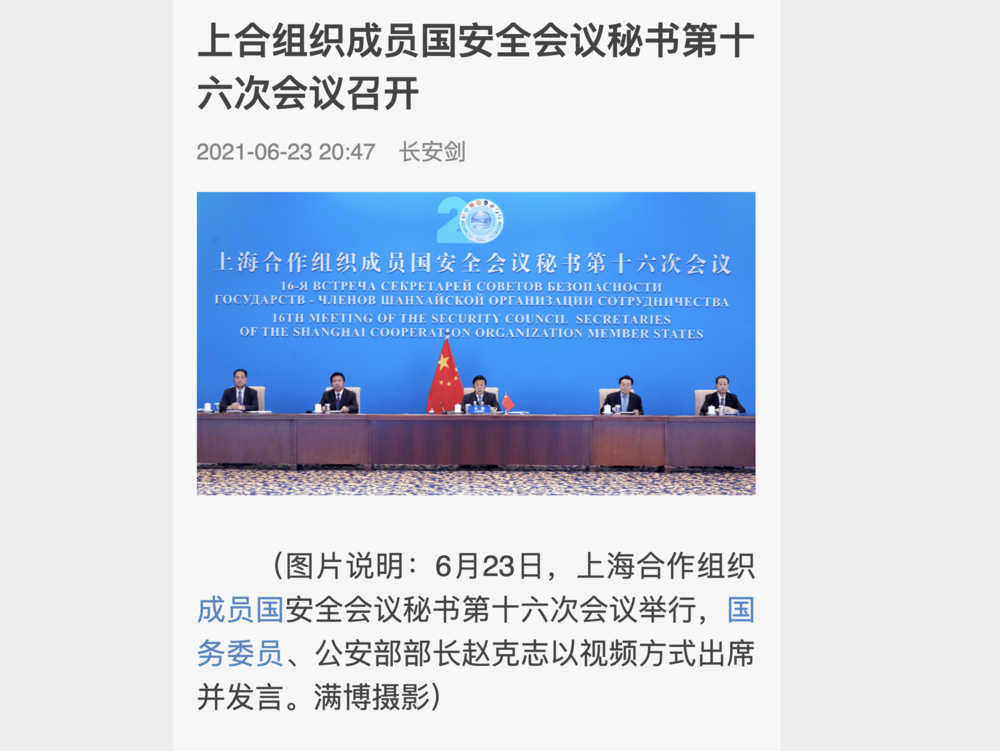
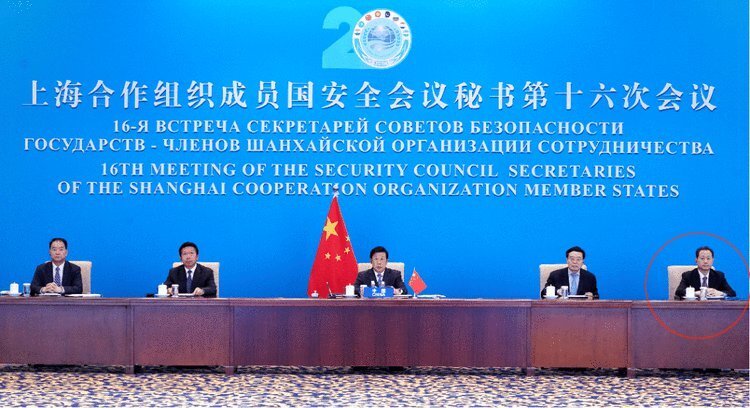
The report didn’t say where this meeting was held.
When I tweeted about this photo and this report, and asked Jennifer Van Laar what her thought was. She replied by saying that “they finally released a bad photoshop. Also, other countries said China didn’t attend, period. It was to be an in-person mtg so if China instead sent 5 ppl by video link. Xi is afraid of officials leaving China. No other country’s saying ‘we saw Dong’ or ‘we talked to Dong.’ …Try again, CCP.”
By the way, Jennifer Van Laar is the managing editor of Red State, who wrote a detailed report about Dong Jingwei’s defection. We quoted her report in our previous show.
I also asked Solomon Yue’s thoughts about this matter. He replied with another photo that has his image in it, obviously photoshopped, and said that “DIA (Defense Intelligence Agency) still has DongJingwei in its protective custody & he is still singing to celebrate CCP 100th birthday. This picture is photoshopped. now I was told that I was there too.”
Obviously Solomon Yue doesn’t believe the CCP’s report and the photo that has Dong Jingwei’s image in it.
By the way, Solomon Yue is the Vice Chairman & CEO at Republicans Overseas, and a senior member of Republican National Committee. He said he had inside information from the DIA, and actually bet with someone that if the news about Dong Jingwei’s defection is not true, he will resign from his post.
He also doesn’t believe that the SpyTalk’s second report is true.
After some investigation, I found that the meeting was held at Tajikistan. Leaders of other countries attended it physically, but nobody from China was there. Only CCP‘s State Councilor & Minister of Public Security Zhao Kezhi made a video appearance as shown in this photo.
The other photo, please show picture C again was faked by the CCP, together with the report of him attending that meeting.
The CCP also released a video report about the meeting, which shows that Dong was in the meeting. This video looks real.
However, after careful study, I found it can also be faked. Why?
Let’s show Picture J. This is the 9th second of that video. This is the most critical frame, and the only frame in the 30 second video that can show Dong was in the meeting. However, for such a critical shot, they used a still photo, not a video shot. Why? As still photos can easily be photoshopped.
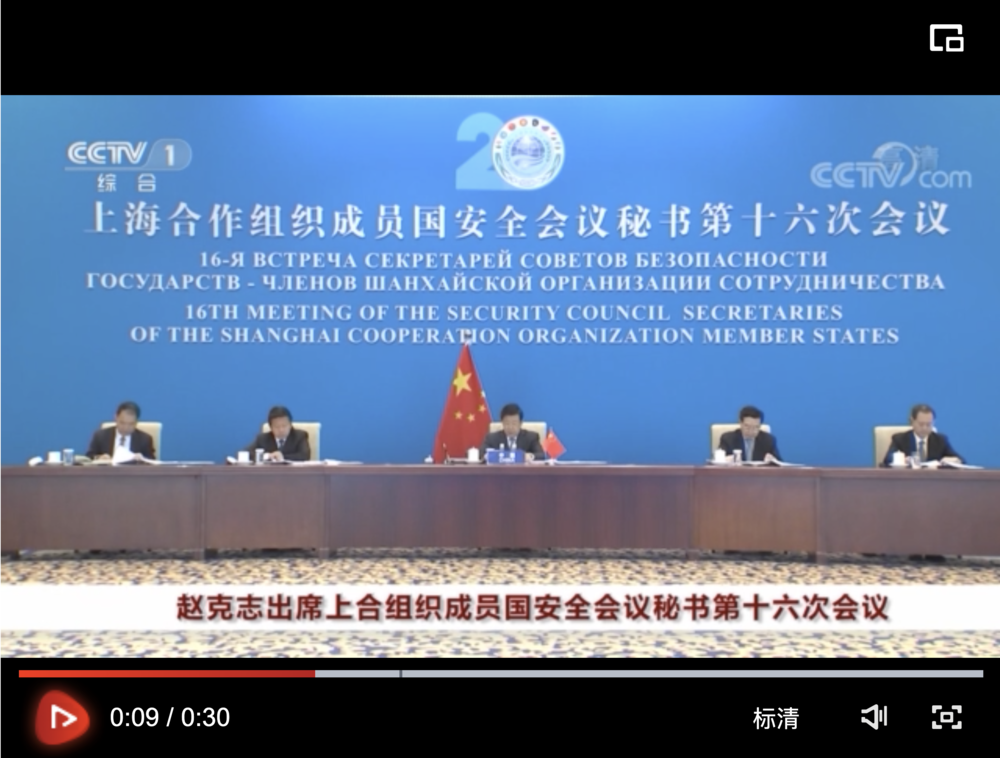
The frame at 9” of the video
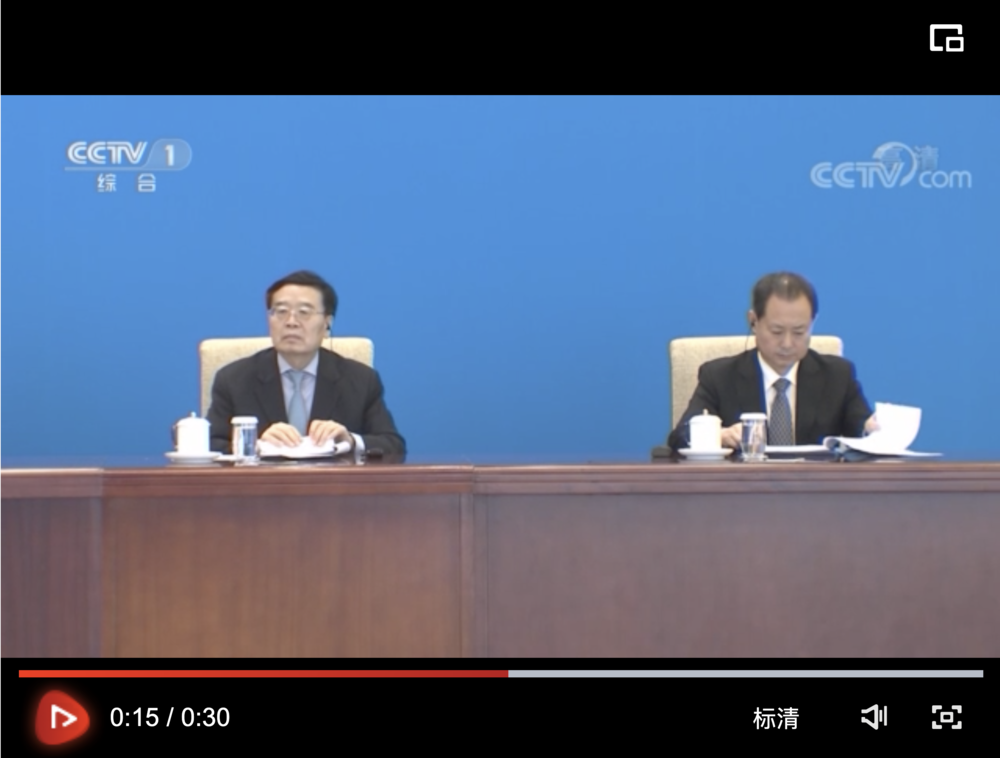
Screen of 13”-15” of the video
At 13”-15″ of the video, they did use a clip showing Dong turning some document, but that clip can be chopped from elsewhere, as it doesn’t have all the other people in it.
I myself also do video editing, so I know the tricks of video editing.
So the above is my analysis. Someone left such a comment on my tweet about this matter: “CCP releasing a fake photoshop trying to show Dong Jingwei at a meeting. Having to fake this is even more proof we have Jingwei at the DIA.”
Well, that’s a little bit of a quick update on Dong Jingwei’s defection. Please feel free to make your own investigation and tell us what you find.
The Leak and the Suicide
Now, let’s move to our next topic, and my exclusive findings.
On June 14, CNN reported that there was leak at Taishan nuclear power plant, and its French owner was warned of an “imminent radiological threat”. The US government had been assessing the situation, etc.
By the way, Taishan nuclear power plant is 30% owned by French company Électricité de France, and 70% owned by China Guangdong Nuclear Power Group.
On June 16, when responding to the CNN report, the head of the National Nuclear Safety Administration of China’s Ministry of Environment Department said that “the increase in the level of radioactivity in the first circuit of Unit 1 is mainly related to the breakage of fuel rods”, but “the results of radiation monitoring around the Taishan Nuclear Power Plant show that there is no radiation abnormality in the environment around the plant” and “no leakage has occurred.”
Then, on the following day, that was June 17, a top Chinese Nuclear Power Expert committed suicide.
Let’s show a screenshot of the video of his suicide. I don’t want to play the video as it is too graphic. Anyway, this 11 second video shows that this nuclear power expert was jumping off his office building and killing himself.
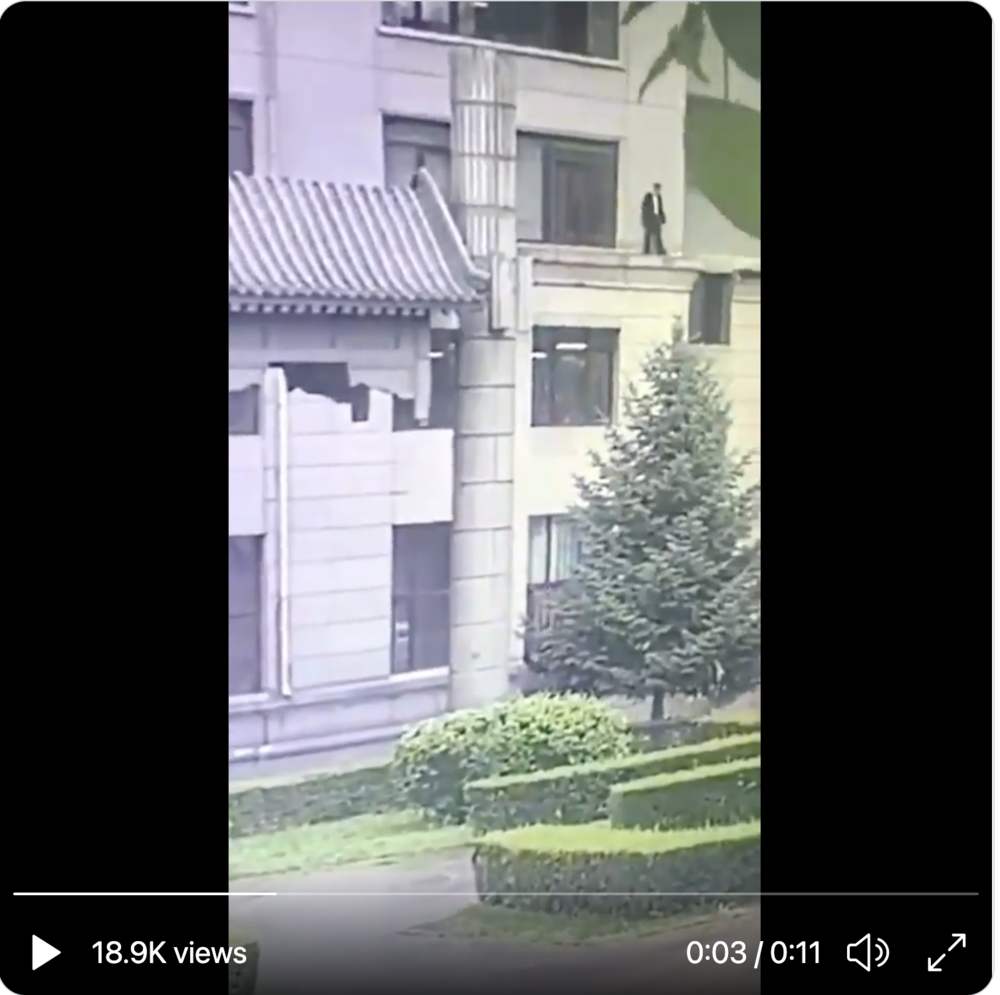
The moment before Zhang Zhijian killed himself.
Who was this expert? Let’s show a photo of him. His name was Zhang Zhijian(张志俭). He was 58 years old, and the deputy principal and a professor of nuclear power at Harbin Engineering University. He was also a high-ranking CCP official, a member of the CCP standing committee at this university.
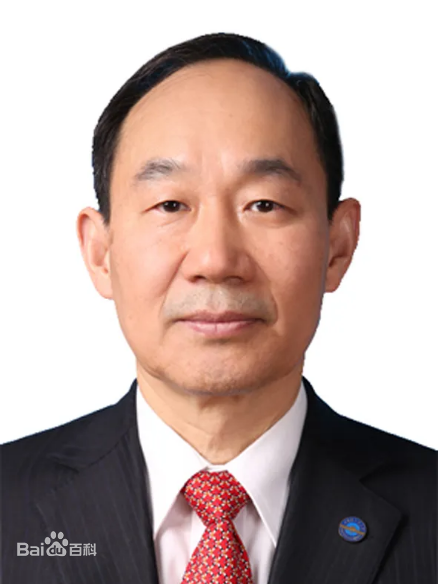
Zhang Zhijian’s profile photo at Baidu.
Public data shows that Zhang held a lot of important academic and administrative offices, including head of the Harbin Engineering University’s College of Nuclear Science and Technology; director of the Nuclear Power Simulation Research Center, one of China’s key national defense labs; chief of the Office of Development and Planning; and an executive director of the Chinese Nuclear Society.
And the Harbin Engineering University has strong ties to the Chinese military.
Historically, it was the predecessor to the People’s Liberation Army Military Institute of Engineering, which was founded with technical support from the former Soviet Union in 1953.
Currently, it’s attached to China’s Ministry of Industry and Information Technology.
Also, the Harbin Engineering University is sanctioned by the U.S. Department of Commerce. It was listed on the Entity List on May 23, 2020, for its involvement in military activities and weapons of mass destruction.
Now, the question is, why did Zhang Zhijian kill himself?
Let’s show picture 6. This is a screenshot of the Harbin Engineering University’s announcement about his death. It only says that he “unfortunately dropped from the building and passed away at about 9:34 am on June 17.” And the police had ruled out the possibility of murder, and we feel very sorry about his death, etc.
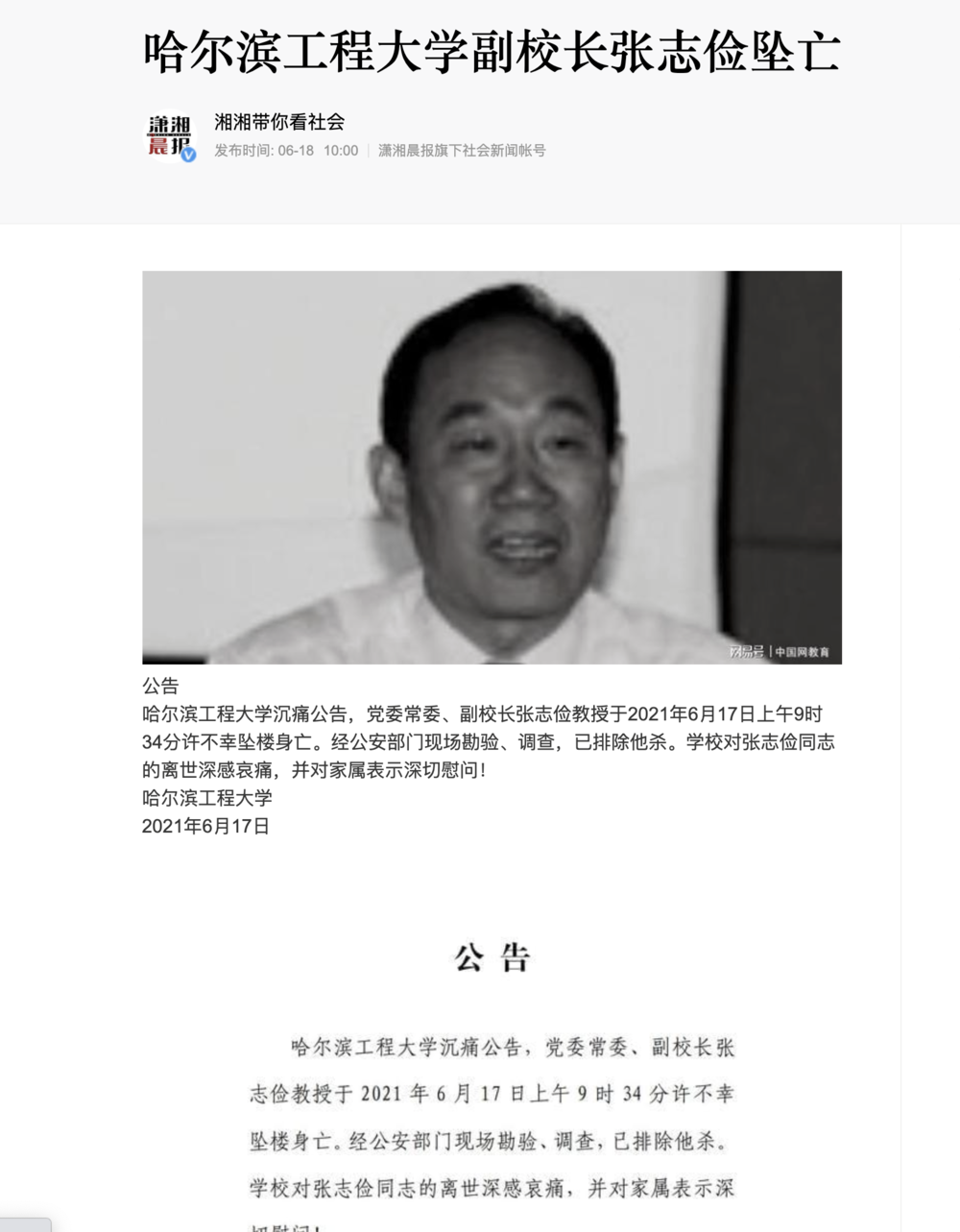
Screenshot of the Harbin Engineering University’s announcement about Zhang Zhijian’s death.
So, there was no explanation about the cause of his death.
An interesting thing is, as early as 2005, Taishan Nuclear Power Plant’s Chinese owner, China Guangdong Nuclear Power Group, signed a cooperation agreement with Harbin Engineering University. According to the agreement, Harbin Engineering University would on the one hand train more talents in nuclear power for China Guangdong Nuclear Power Group, and on the other hand, do more research.
It was said that the cooperation would promote the transformation of scientific research results into productivity through the combination of industry, academia and research.
Several months after the agreement was signed, in December 2005, Harbin Engineering University established its College of Nuclear Science and Technology, and Zhang Zhijian was the head of this college.
Then, two years later, in 2007, China and France signed an agreement to co-build Tashan Nuclear Power Plant.
The construction of Unit 1 and Unit 2 of Tashan Nuclear Power Plant started in 2009, and Unit 1 entered commercial operation on December 13, 2018.
Then, if you check Zhang Zhijian’s bio, you would find that he had been the head of the College of Nuclear Science and Technology for ten years, from 2005 to 2015.
This overlapped with Tashan Nuclear Power Plant‘s design and construction period.
During this period of time, it is very likely that Zhang Zhijian had formed a huge network with China Guangdong Nuclear Power Group and maybe other companies, institutions and officials involved in nuclear energy.
So, Chinese commentator Zhou Xiaohui said in his article that he highly suspected that Zhang Zhijian’s suicide had something to do with the leak of Taishan Nuclear Power Plant, given he killed himself right after the CCP publicly responded to the leak, and given his close ties with China Guangdong Nuclear Power Group, as well as the entire nuclear power industry in China.
Zhou Xiaohui said, maybe Zhang Zhijian had already been questioned by the authorities, or maybe he was given some sort of pressure, or maybe he was too frightened by the incident, or maybe he was afraid that he would be held responsible, or maybe there was something he needed to cover up with his death, etc.
So, what do you think? Taking one’s own life is not an easy decision. Why did he make such a difficult decision as a top nuclear power expert? I do think there are a lot of questions to ask here.
China May Become the No. 1 Nuclear Energy Country by 2030
According to China Nuclear Energy Development Report 2021, as of December 2020, China had 17 nuclear power units under construction, with a total installed capacity of 18.53GW, keeping the world’s largest installed capacity of units under construction for many years.
The CCP began building nuclear power stations in the mid-1980s. The first large commercial nuclear power plant in China, Daya Bay Nuclear Power Station, went into commercial operation in May 1994. This nuclear power plant adjacent to Hong Kong exports roughly 70 percent of its annual electricity into Hong Kong and sells 30 percent to Guangdong.
Since then, the CCP has gradually accelerated the development of nuclear power plants.
Let’s see Picture 9. This is the past and projected future nuclear power capacity. The unit is GW.
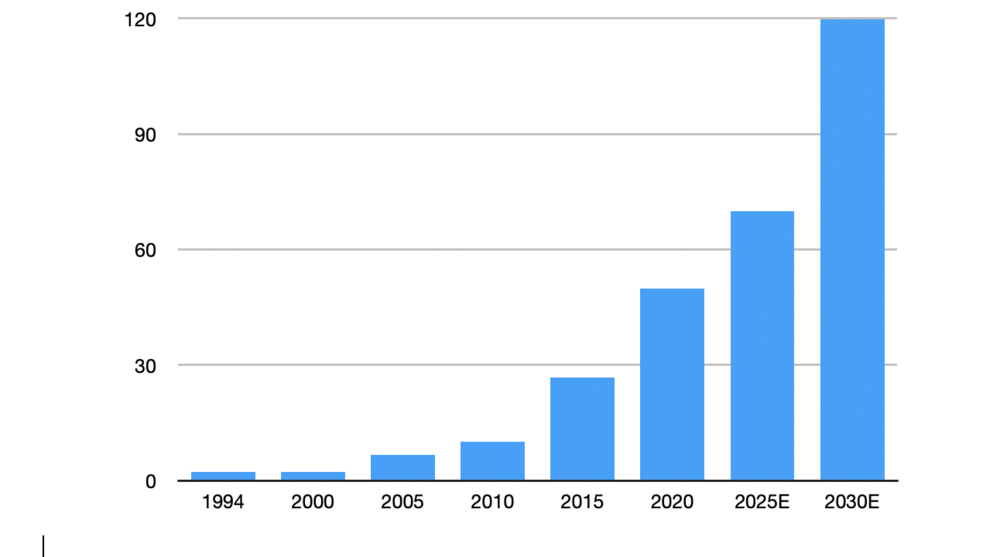
A screenshot of the nuclear capacity of China (unit: GW) from China Electricity Council, World Nuclear Association. (Screenshot via The Epoch Times)
By the end of 2020, China’s installed nuclear power capacity has reached 49.89 GW, ranking third in the world behind the United States and France.
In terms of nuclear power generation, China ranked second in the world in 2020, with 366.2 TWh.
In its 14th Five-Year economic development Plan, the CCP stated that China’s nuclear power installation in operation would rapidly increase to 70GW by 2025 and 120GW by 2030.
Currently, there are 62 nuclear power units in China, of which 49 are in operation, mainly in the coastal areas of China.
In the meantime, the U.S., the world’s largest nuclear power country, reached its peak of 102 GW of installed nuclear power in 2012. Its first nuclear unit went into commercial operation in 1969, and has since declined as some units have been retired.
By the end of 2020, U.S. nuclear capacity has fallen to 96.5 GW. At this rate, China is likely to overtake the United States as the world’s top nuclear power producer by 2030.
Let’s show picture 10. So these are the nuclear power plants in China. The map was created by World Nuclear Association

A screenshot of nuclear power plants in China from World Nuclear Association. (Screenshot via The Epoch Times)
CCP’s Goal: Export Nuclear Energy
Nuclear energy is a strategic industry for the CCP, which has ambitiously exported nuclear energy technology overseas.
On February 26, 2015, Wang Xiaotao, deputy director of the Development and Reform Commission of China, said that the CCP would promote the export of railroads and nuclear power, and develop the international market for major equipment in the railroad and nuclear power industries.
On January 11, 2016, the Central CCP Government wrote on its website, “In our country’s ‘One Belt, One Road’ strategy, nuclear power, like high-speed rail, has the characteristics of high core technology threshold, high initial investment, high industry barriers and scarce industry licenses, and is a strategic industry that the country focuses on supporting.”
“For every nuclear power unit exported, more than 80,000 sets of equipment are needed and more than 200 enterprises are involved in manufacturing and construction, creating about 150,000 jobs and an investment demand of 30 billion yuan ($4.63 billion). Experts estimate that if China can obtain 20 percent of the market share of countries along the ‘Belt and Road,’ i.e. about 30 units for overseas markets, it will directly generate nearly 1 trillion yuan [about $154 billion] of output value and create 5 million jobs.”
According to the World Nuclear Association, the CCP is currently exporting Chinese nuclear power to 12 countries, including Pakistan, Romania, Argentina, the United Kingdom, Iran, Turkey, South Africa, Kenya, Egypt, Sudan, Armenia, and Kazakhstan.
The ambition to export nuclear power technology overseas has pushed the Chinese regime to develop its Generation III nuclear technologies such as the Hualong One Reactor, developed by state-owned China General Nuclear Power Group, and the CAP1400 Reactor, developed by the State Power Investment Corporation.
However, the development of Hualong One, CAP1400, and Chinese nuclear plants were based on foreign technologies.
A report by the CCP’s mouthpiece Xinhua says, “In addition to the self-designed Qinshan I nuclear power plant, China also cooperated with France to build the Daya Bay Nuclear Power Plant, following the route of ‘introduction, digestion and absorption.’.”
The CAP1400 nuclear reactor is based on the US Westinghouse AP1000 technology.
The CCP’s mouthpiece People’s Daily boasted that China has mastered the third generation of nuclear power technology after the United States, France, Russia and other countries, and the level of China’s nuclear power technology has entered the world’s top tier.
Promoting Nuclear Energy Is a Means to “Build a Human Community with a Shared Future”
On Sept. 3, 2019, China’s Information Office of the State Council released the first white paper on nuclear safety. In that white paper, the CCP mentions the need to build “a common community with a shared future for nuclear safety ” to promote the construction of “a human community with a shared future.”
The concept of building a “Human Community with a Shared Future” came from Xi Jinping in 2012 at the CCP’s 18th National Congress.
However, the CCP is pushing ahead with its nuclear power projects without taking safety issues into full consideration.
For example, the Taishan Nuclear Power Plant was built in 2009 using the European Evolutionary Power Reactors (EPRs). This technology was also used in the construction of the Olkiluoto 3 unit in Finland in 2005 and the Flamanville nuclear power station in France in 2007. However, both the Finnish and French plants are currently on hold due to technical and safety standard issues.
In April 2015, the French Nuclear Safety Authority issued a warning to the French company Flamanville about “an anomaly in the composition of the steel in certain zones of the reactor vessel head and reactor vessel bottom head of the Flamanville EPR.”
In 2016, Chinese news portal Sina.com revealed that two EPR reactors at the Taishan plant were reported as having failed pressure vessels.
At the same time, several media outlets reported that the power plant’s French supplier Framatome (formerly known as Areva) said that 400 components were improperly tested for safety.
However, two years later, in 2018, while the EPR units in Finland and France were stalled due to safety concerns, the Chinese Taishan nuclear power station began commercial operation.
Chinese scholar and energy expert Nieh Sen said to the Epoch Times that the CCP takes huge risks in developing nuclear power and “such a dangerous regime is exporting nuclear power plants to the world.”
He said, “At such a time, it is important to know the truth. What is the operational status of the nuclear power plants in China? What is the safety level? All these need urgent global attention.”
Well, that’s all for today’s Inconvenient Truths. Thank you very much for watching! See you next Monday!
6/24/2021*
Donate to me directly 直接捐款:https://donorbox.org/inconvenient-truths-by-jennifer-zeng
Subscribestar 會員頻道: https://bit.ly/3fEzeJB
YouTube 油管:bit.ly/3b87DPj
GoFundme 衆籌:https://bit.ly/2zx6LVw
Patreon 網站:https://bit.ly/3cvBy3H
Paypal 捐款:http://paypal.me/JenniferZeng97
Bitcoin 捐款:bc1qlkkvwyvw96x3xx6jgzkhlnnv0nv3d9vm078vfd

Exclusive: Leak at Taishan, Suicide of Top Nuclear Power Expert & The CCP’s Dangerous Ambition
Hello, everyone, welcome to “Inconvenient Truths”. I am your host Jennifer Zeng.
A while ago there was a leak in China’s Taishan Nuclear Power Plant, which is very close to Hong Kong. The leak has caused a lot of media attention, and a viewer asked me to talk about it. So today I will not only talk about the incident itself, but will also talk about a suicide that could have some connection with the leak. No other English media has covered this. So this is my exclusive report.
I will then give you an in-depth coverage of the CCP’s ambitious “nuclear dream”, and explain why the world should be very worried about it.
I will also give you a quick update about the issues surrounding the defection of CCP’s top counterintelligence official Dong Jingwei.
Before we move on, please make sure you subscribe to and share my channel.
One viewer left a comment on my last show, saying that “I am really surprised why this channel has so less subscribers and so less likes… really surprising.. I think people cannot digest truth neither convenient or inconvenient”.
And my reply is: “I think we need to thank YouTube for this too…”
Another viewer said, “Hi Jennifer, I conducted a little experiment on your channel. I had three identical devices watching your broadcast at the same time. I hit a like on one device but it didn’t register on the other two. I then did the same on the other two devices and the same thing happened. Also the number of people watching was different on each device. The number consistently dropped throughout the broadcast on two devices.”
So, you see, we do need to fight hard against the suppression. And thank you very much for your support.
Now, let’s move to our topics today.
Quick Updates about Dong Jingwei’s Alleged Defection
We talked about reports about Dong Jingwei’s defection, and the CCP’s strange responses in our last show.
Since then there have been two major updates.
One is that SpyTalk, which published a story about Dong Jingwen before, was approached by “a U.S. official” who said that the reports about Dong Jingwen were “not accurate”.
Another is that the CCP published a report yesterday (June 23), with a photo that has Dong in it, saying that Dong attended the 16th meeting of the security council secretaries of the Shanghai Cooperation Organization member states.
The report didn’t say where this meeting was held.
When I tweeted about this photo and this report, and asked Jennifer Van Laar what her thought was. She replied by saying that “they finally released a bad photoshop. Also, other countries said China didn’t attend, period. It was to be an in-person mtg so if China instead sent 5 ppl by video link. Xi is afraid of officials leaving China. No other country’s saying ‘we saw Dong’ or ‘we talked to Dong.’ …Try again, CCP.”
By the way, Jennifer Van Laar is the managing editor of Red State, who wrote a detailed report about Dong Jingwei’s defection. We quoted her report in our previous show.
I also asked Solomon Yue’s thoughts about this matter. He replied with another photo that has his image in it, obviously photoshopped, and said that “DIA (Defense Intelligence Agency) still has DongJingwei in its protective custody & he is still singing to celebrate CCP 100th birthday. This picture is photoshopped. now I was told that I was there too.”
Obviously Solomon Yue doesn’t believe the CCP’s report and the photo that has Dong Jingwei’s image in it.
By the way, Solomon Yue is the Vice Chairman & CEO at Republicans Overseas, and a senior member of Republican National Committee. He said he had inside information from the DIA, and actually bet with someone that if the news about Dong Jingwei’s defection is not true, he will resign from his post.
He also doesn’t believe that the SpyTalk’s second report is true.
After some investigation, I found that the meeting was held at Tajikistan. Leaders of other countries attended it physically, but nobody from China was there. Only CCP‘s State Councilor & Minister of Public Security Zhao Kezhi made a video appearance as shown in this photo.
The other photo, please show picture C again was faked by the CCP, together with the report of him attending that meeting.
The CCP also released a video report about the meeting, which shows that Dong was in the meeting. This video looks real.
However, after careful study, I found it can also be faked. Why?
Let’s show Picture J. This is the 9th second of that video. This is the most critical frame, and the only frame in the 30 second video that can show Dong was in the meeting. However, for such a critical shot, they used a still photo, not a video shot. Why? As still photos can easily be photoshopped.
The frame at 9” of the video
Screen of 13”-15” of the video
At 13”-15″ of the video, they did use a clip showing Dong turning some document, but that clip can be chopped from elsewhere, as it doesn’t have all the other people in it.
I myself also do video editing, so I know the tricks of video editing.
So the above is my analysis. Someone left such a comment on my tweet about this matter: “CCP releasing a fake photoshop trying to show Dong Jingwei at a meeting. Having to fake this is even more proof we have Jingwei at the DIA.”
Well, that’s a little bit of a quick update on Dong Jingwei’s defection. Please feel free to make your own investigation and tell us what you find.
The Leak and the Suicide
Now, let’s move to our next topic, and my exclusive findings.
On June 14, CNN reported that there was leak at Taishan nuclear power plant, and its French owner was warned of an “imminent radiological threat”. The US government had been assessing the situation, etc.
By the way, Taishan nuclear power plant is 30% owned by French company Électricité de France, and 70% owned by China Guangdong Nuclear Power Group.
On June 16, when responding to the CNN report, the head of the National Nuclear Safety Administration of China’s Ministry of Environment Department said that “the increase in the level of radioactivity in the first circuit of Unit 1 is mainly related to the breakage of fuel rods”, but “the results of radiation monitoring around the Taishan Nuclear Power Plant show that there is no radiation abnormality in the environment around the plant” and “no leakage has occurred.”
Then, on the following day, that was June 17, a top Chinese Nuclear Power Expert committed suicide.
Let’s show a screenshot of the video of his suicide. I don’t want to play the video as it is too graphic. Anyway, this 11 second video shows that this nuclear power expert was jumping off his office building and killing himself.
The moment before Zhang Zhijian killed himself.
Who was this expert? Let’s show a photo of him. His name was Zhang Zhijian(张志俭). He was 58 years old, and the deputy principal and a professor of nuclear power at Harbin Engineering University. He was also a high-ranking CCP official, a member of the CCP standing committee at this university.
Zhang Zhijian’s profile photo at Baidu.
Public data shows that Zhang held a lot of important academic and administrative offices, including head of the Harbin Engineering University’s College of Nuclear Science and Technology; director of the Nuclear Power Simulation Research Center, one of China’s key national defense labs; chief of the Office of Development and Planning; and an executive director of the Chinese Nuclear Society.
And the Harbin Engineering University has strong ties to the Chinese military.
Historically, it was the predecessor to the People’s Liberation Army Military Institute of Engineering, which was founded with technical support from the former Soviet Union in 1953.
Currently, it’s attached to China’s Ministry of Industry and Information Technology.
Also, the Harbin Engineering University is sanctioned by the U.S. Department of Commerce. It was listed on the Entity List on May 23, 2020, for its involvement in military activities and weapons of mass destruction.
Now, the question is, why did Zhang Zhijian kill himself?
Let’s show picture 6. This is a screenshot of the Harbin Engineering University’s announcement about his death. It only says that he “unfortunately dropped from the building and passed away at about 9:34 am on June 17.” And the police had ruled out the possibility of murder, and we feel very sorry about his death, etc.
Screenshot of the Harbin Engineering University’s announcement about Zhang Zhijian’s death.
So, there was no explanation about the cause of his death.
An interesting thing is, as early as 2005, Taishan Nuclear Power Plant’s Chinese owner, China Guangdong Nuclear Power Group, signed a cooperation agreement with Harbin Engineering University. According to the agreement, Harbin Engineering University would on the one hand train more talents in nuclear power for China Guangdong Nuclear Power Group, and on the other hand, do more research.
It was said that the cooperation would promote the transformation of scientific research results into productivity through the combination of industry, academia and research.
Several months after the agreement was signed, in December 2005, Harbin Engineering University established its College of Nuclear Science and Technology, and Zhang Zhijian was the head of this college.
Then, two years later, in 2007, China and France signed an agreement to co-build Tashan Nuclear Power Plant.
The construction of Unit 1 and Unit 2 of Tashan Nuclear Power Plant started in 2009, and Unit 1 entered commercial operation on December 13, 2018.
Then, if you check Zhang Zhijian’s bio, you would find that he had been the head of the College of Nuclear Science and Technology for ten years, from 2005 to 2015.
This overlapped with Tashan Nuclear Power Plant‘s design and construction period.
During this period of time, it is very likely that Zhang Zhijian had formed a huge network with China Guangdong Nuclear Power Group and maybe other companies, institutions and officials involved in nuclear energy.
So, Chinese commentator Zhou Xiaohui said in his article that he highly suspected that Zhang Zhijian’s suicide had something to do with the leak of Taishan Nuclear Power Plant, given he killed himself right after the CCP publicly responded to the leak, and given his close ties with China Guangdong Nuclear Power Group, as well as the entire nuclear power industry in China.
Zhou Xiaohui said, maybe Zhang Zhijian had already been questioned by the authorities, or maybe he was given some sort of pressure, or maybe he was too frightened by the incident, or maybe he was afraid that he would be held responsible, or maybe there was something he needed to cover up with his death, etc.
So, what do you think? Taking one’s own life is not an easy decision. Why did he make such a difficult decision as a top nuclear power expert? I do think there are a lot of questions to ask here.
China May Become the No. 1 Nuclear Energy Country by 2030
According to China Nuclear Energy Development Report 2021, as of December 2020, China had 17 nuclear power units under construction, with a total installed capacity of 18.53GW, keeping the world’s largest installed capacity of units under construction for many years.
The CCP began building nuclear power stations in the mid-1980s. The first large commercial nuclear power plant in China, Daya Bay Nuclear Power Station, went into commercial operation in May 1994. This nuclear power plant adjacent to Hong Kong exports roughly 70 percent of its annual electricity into Hong Kong and sells 30 percent to Guangdong.
Since then, the CCP has gradually accelerated the development of nuclear power plants.
Let’s see Picture 9. This is the past and projected future nuclear power capacity. The unit is GW.
A screenshot of the nuclear capacity of China (unit: GW) from China Electricity Council, World Nuclear Association. (Screenshot via The Epoch Times)
By the end of 2020, China’s installed nuclear power capacity has reached 49.89 GW, ranking third in the world behind the United States and France.
In terms of nuclear power generation, China ranked second in the world in 2020, with 366.2 TWh.
In its 14th Five-Year economic development Plan, the CCP stated that China’s nuclear power installation in operation would rapidly increase to 70GW by 2025 and 120GW by 2030.
Currently, there are 62 nuclear power units in China, of which 49 are in operation, mainly in the coastal areas of China.
In the meantime, the U.S., the world’s largest nuclear power country, reached its peak of 102 GW of installed nuclear power in 2012. Its first nuclear unit went into commercial operation in 1969, and has since declined as some units have been retired.
By the end of 2020, U.S. nuclear capacity has fallen to 96.5 GW. At this rate, China is likely to overtake the United States as the world’s top nuclear power producer by 2030.
Let’s show picture 10. So these are the nuclear power plants in China. The map was created by World Nuclear Association
A screenshot of nuclear power plants in China from World Nuclear Association. (Screenshot via The Epoch Times)
CCP’s Goal: Export Nuclear Energy
Nuclear energy is a strategic industry for the CCP, which has ambitiously exported nuclear energy technology overseas.
On February 26, 2015, Wang Xiaotao, deputy director of the Development and Reform Commission of China, said that the CCP would promote the export of railroads and nuclear power, and develop the international market for major equipment in the railroad and nuclear power industries.
On January 11, 2016, the Central CCP Government wrote on its website, “In our country’s ‘One Belt, One Road’ strategy, nuclear power, like high-speed rail, has the characteristics of high core technology threshold, high initial investment, high industry barriers and scarce industry licenses, and is a strategic industry that the country focuses on supporting.”
“For every nuclear power unit exported, more than 80,000 sets of equipment are needed and more than 200 enterprises are involved in manufacturing and construction, creating about 150,000 jobs and an investment demand of 30 billion yuan ($4.63 billion). Experts estimate that if China can obtain 20 percent of the market share of countries along the ‘Belt and Road,’ i.e. about 30 units for overseas markets, it will directly generate nearly 1 trillion yuan [about $154 billion] of output value and create 5 million jobs.”
According to the World Nuclear Association, the CCP is currently exporting Chinese nuclear power to 12 countries, including Pakistan, Romania, Argentina, the United Kingdom, Iran, Turkey, South Africa, Kenya, Egypt, Sudan, Armenia, and Kazakhstan.
The ambition to export nuclear power technology overseas has pushed the Chinese regime to develop its Generation III nuclear technologies such as the Hualong One Reactor, developed by state-owned China General Nuclear Power Group, and the CAP1400 Reactor, developed by the State Power Investment Corporation.
However, the development of Hualong One, CAP1400, and Chinese nuclear plants were based on foreign technologies.
A report by the CCP’s mouthpiece Xinhua says, “In addition to the self-designed Qinshan I nuclear power plant, China also cooperated with France to build the Daya Bay Nuclear Power Plant, following the route of ‘introduction, digestion and absorption.’.”
The CAP1400 nuclear reactor is based on the US Westinghouse AP1000 technology.
The CCP’s mouthpiece People’s Daily boasted that China has mastered the third generation of nuclear power technology after the United States, France, Russia and other countries, and the level of China’s nuclear power technology has entered the world’s top tier.
Promoting Nuclear Energy Is a Means to “Build a Human Community with a Shared Future”
On Sept. 3, 2019, China’s Information Office of the State Council released the first white paper on nuclear safety. In that white paper, the CCP mentions the need to build “a common community with a shared future for nuclear safety ” to promote the construction of “a human community with a shared future.”
The concept of building a “Human Community with a Shared Future” came from Xi Jinping in 2012 at the CCP’s 18th National Congress.
However, the CCP is pushing ahead with its nuclear power projects without taking safety issues into full consideration.
For example, the Taishan Nuclear Power Plant was built in 2009 using the European Evolutionary Power Reactors (EPRs). This technology was also used in the construction of the Olkiluoto 3 unit in Finland in 2005 and the Flamanville nuclear power station in France in 2007. However, both the Finnish and French plants are currently on hold due to technical and safety standard issues.
In April 2015, the French Nuclear Safety Authority issued a warning to the French company Flamanville about “an anomaly in the composition of the steel in certain zones of the reactor vessel head and reactor vessel bottom head of the Flamanville EPR.”
In 2016, Chinese news portal Sina.com revealed that two EPR reactors at the Taishan plant were reported as having failed pressure vessels.
At the same time, several media outlets reported that the power plant’s French supplier Framatome (formerly known as Areva) said that 400 components were improperly tested for safety.
However, two years later, in 2018, while the EPR units in Finland and France were stalled due to safety concerns, the Chinese Taishan nuclear power station began commercial operation.
Chinese scholar and energy expert Nieh Sen said to the Epoch Times that the CCP takes huge risks in developing nuclear power and “such a dangerous regime is exporting nuclear power plants to the world.”
He said, “At such a time, it is important to know the truth. What is the operational status of the nuclear power plants in China? What is the safety level? All these need urgent global attention.”
Well, that’s all for today’s Inconvenient Truths. Thank you very much for watching! See you next Monday!
6/24/2021*
Donate to me directly 直接捐款:https://donorbox.org/inconvenient-truths-by-jennifer-zeng
Subscribestar 會員頻道: https://bit.ly/3fEzeJB
YouTube 油管:bit.ly/3b87DPj
GoFundme 衆籌:https://bit.ly/2zx6LVw
Patreon 網站:https://bit.ly/3cvBy3H
Paypal 捐款:http://paypal.me/JenniferZeng97
Bitcoin 捐款:bc1qlkkvwyvw96x3xx6jgzkhlnnv0nv3d9vm078vfd